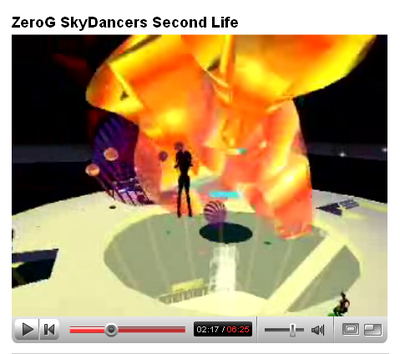December 08, 2006
YOUR TUBE, YOUR IMAGINATION
Dancoyote_antonelli_and_skydancers
Online world as new artist's medium. I haven't had a chance to attend a performance designed by DanCoyote Antonelli, founder of a new school of metaverse-era art theory he calls hyperformalism, but Gary Hazlitt has. Hazlitt shot at a recent showing of Antonelli's ZeroG SkyDancers (evocative, though it's clear you need to attend the show in-person, to get its full power), then read his detailed and thought-provoking write-up of the event and interview with Antonelli here. [blogged by W. James Au on New World Notes]
Hyperformalism is an aesthetic philosphical construct that may be employed by to describe a late 20th century, early 21st century mass art phenomena consisting of scores of personal computer users generating abstract, often spacially unique artworks with software tools.
These spacial realities have no analog in the physical world, and instead of making reference to physical reality, create a unique continuum of reference; a rearrangement of photons to illuminate alternate worlds of form, shape, color and space.
The term Hyperformalism is derived from the combination of the words Hyper and Formalism (as described by WikiPedia) and is being used here to describe aesthetic self expression without anthropomorphic, or representative context. This seperates Hyperformalism from digital collage, aesthetic photo manipulation and other forms.
Hyperformalism is not anthropomorphic or representational. Often times hyperformal art may resemble natural formations or even employ naturalistic algorythms such as the work of Casey Reas which is described on the aforementioned website as "stringently defined yet wonderfully organic".
Other times hyperformal artwork takes a more industrial or unnatural form such as the work of Shirley Shor
Hyperformalism may be flat like Casey Reas or spacial like Shirley Shor but never contains recognizable elements like text, figures, landscapes, objects and concepts relating to humanity.
Hyperformalism, the product of a desktop computer, suffers from stigmatization of its association with computers and has yet to find a neutral delivery platform. This means that vast amounts of work is being created, at the pace of technological change, without the hope of display beyond a desktop computer screen.
Since most of the material viewers are accustomed to encountering on a desktop computer screen is commercial in nature, disposable consumer culture, it is a hard sell to suddenly invoke the weight of culturally important artifact on to such a homely delivery platform.
Guilt by association...
Posted by jo at December 8, 2006 08:58 AM

